Next: CMOS Digital Logic Circuits Up: ch4 Previous: Metal-Oxide-Semiconductor Field-Effect Transistors
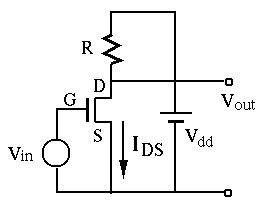
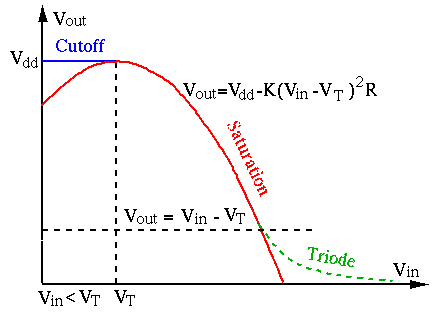
Assume in the circuit above


 |
(160) |
 to the input
to the input  , as
shown by the red segment of the curve in the plot above. As the transistor is
in saturation region,
, as
shown by the red segment of the curve in the plot above. As the transistor is
in saturation region,
 |
(161) |
 to get:
to get:
 i.e. i.e. |
(162) |
 needs to satisfy both
needs to satisfy both
 and the inequality above, i.e., it
needs to be in the following range:
and the inequality above, i.e., it
needs to be in the following range:
 i.e. i.e. |
(163) |
When the transistor is in saturation mode the slope of the curve (red)
indicates the ratio between input 

 |
(164) |
Example: Assume





![$V_{in}<[-1+\sqrt{1+4KRV_{dd}}\;]/2KR+V_T=2.32\;V $](img679.svg)
 |
(165) |
 :
:
 |
(166) |
 |
0 | 1 | 1.4 | 1.5 | 1.8 | 1.9 | 2.0 | 2.1 | 2.2 | 2.3 | 2.32 | 2.35 | 2.4 | ||
 |
10 | 10 | 9.2 | 8.8 | 6.8 | 6.0 | 5.0 | 4.0 | 2.8 | 1.6 | 1.3 | 0.9 | 0.0 |
 increases from
increases from  to
to  , the output
, the output
 decreases from
decreases from  to
to  , with a gain
, with a gain
 .
Also when the input
.
Also when the input  increases from
increases from  to
to  , the output
, the output  decreases from
decreases from  to
to  , with a gain
, with a gain
 .
.
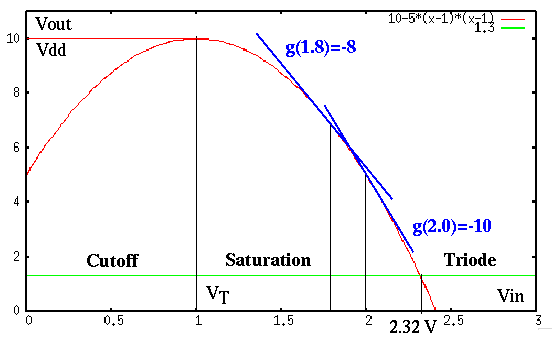
In summary, we see that
 .
.
 . When
. When
 , the gain
, the gain  is greater than one.
is greater than one.
 out of phase with the input voltage (
out of phase with the input voltage ( ),
as the slope of
),
as the slope of
 is negative.
is negative.
 , the transistor is cutoff. On the other hand, when
, the transistor is cutoff. On the other hand, when
 ,
,  is more than one
is more than one  below
below  , for example,
, for example,
 ,
,
 , the transistor is in triode
region. In either of the two cases, the transistor has no amplification capability.
, the transistor is in triode
region. In either of the two cases, the transistor has no amplification capability.
Next we consider a MOSFET circuit with sinusoidal input. Assume the drain resistor
is







 |
(167) |
 , the output voltage
, the output voltage
 and the current
and the current  are, respectively,
are, respectively,
 ,
and
,
and
 , as shown in the figure below:
, as shown in the figure below:
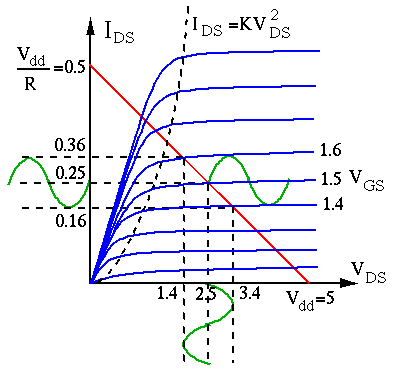
Biasing: In the example above, the DC offset of the input is at 1.5V, so that the transistor is working in the saturation region when the magnitude of the AC input is limited. However, if this offset is either too high or too low, the gate voltage may go beyond the saturation region to enter either the triode or the cutoff region. In either case, the output voltage will be severely distorted, as shown below:
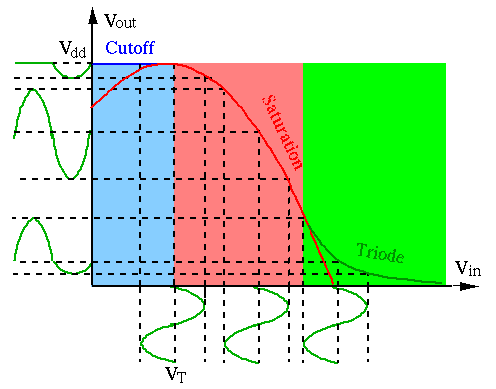
It is therefore clear that the DC offset or biasing gate voltage has to be properly setup to make sure the dynamic range of the input signal is within the saturation region.
Method 1: One way to provide the desired DC offset is to use two resistors


 |
(168) |
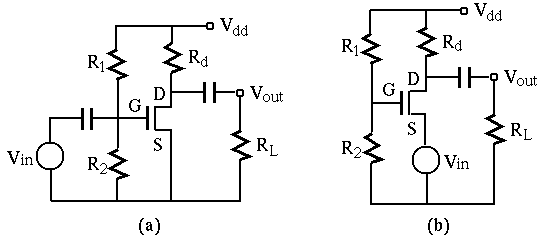
Method 2: Another way to set up the bias is the circuit shown in (b) above.
Assume 






 |
(169) |
 ,
,
 .
.
To determine the dynamic range of the input 
 . For this particular circuit,
. For this particular circuit,
 |
(170) |
 with corresponding output
with corresponding output
 .
.
 . For this particular circuit,
. For this particular circuit,
 |
(171) |
 |
(172) |
 |
(173) |
 we get
we get
 , with corresponding output
, with corresponding output

 |
(174) |
 |
(175) |
 . Note that the output voltage is in
phase with the input voltage.
. Note that the output voltage is in
phase with the input voltage.
Source Follower: If the output is taken from the source, instead of the drain of the transistor, the circuit is called a source follower.
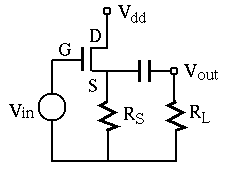
Assume




 |
(176) |
 |
(177) |
 , this equation becomes:
, this equation becomes:
 |
(178) |
 or
or
 . We take the smaller
voltage in order for the transistor to be outside the cutoff region:
. We take the smaller
voltage in order for the transistor to be outside the cutoff region:
 |
(179) |
 , the equation becomes:
, the equation becomes:
 |
(180) |
 . The voltage gain of the source follower is
. The voltage gain of the source follower is
 |
(181) |
To maximize the dynamic range for the input AC signal, the DC operation point
in terms of the DC variables

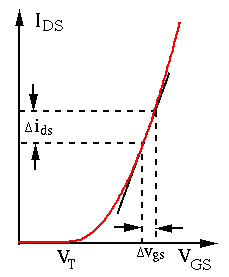
Specifically, the nonlinear relationship between 

 |
(182) |
 , called incremental transconductance, is the ratio between small
change in
, called incremental transconductance, is the ratio between small
change in  and the small change in
and the small change in  .
.